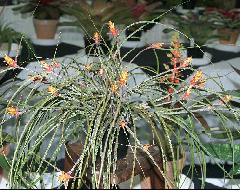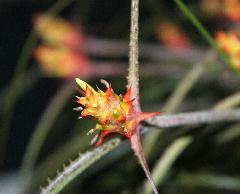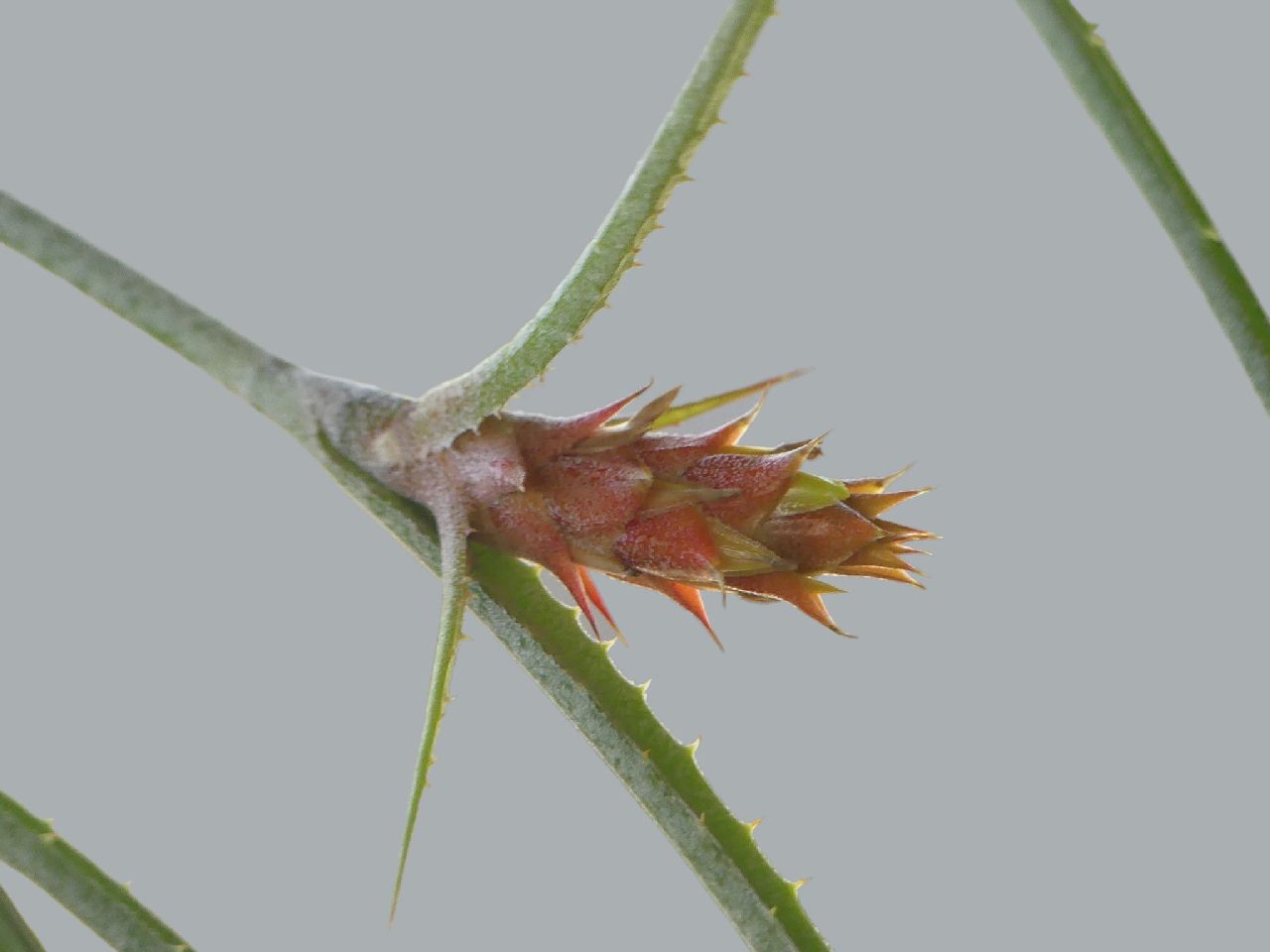Acanthostachys strobilacea
Click thumbnails for full size, scaled to a new window.
Acanthostachys strobilacea



| Birgit Rhode, Aukland, at Bromeliad XIII competition 10/05 |
Ian Hook 12/18 |
Acanthostachys strobilacea (Schultes filius) Klotzsch in Link, Klotzsch & Otto, Ic. Pl. Rar. Hort. Berol. 1: 21, pl. 9. 1840 ('1841').
Hohenbergia strobilacea Schultes filius in Roemer & Schultes, Syst. 7(2): 1252. 1830.
Acanthostachys exilis Bertoni, Anales Cientificos Paraguayos 11. no. 4: 301. 1919.
Type. Paraguay, Bertoni 3080 (AS n v). Synonymy fide Castellanos.
Desc from S&D
Plant flowering 0.2-2 m high, erect at first but often the whole plant becoming pendulous, propagating by short stout basal rhizomes.
Leaves very few, fasciculate, erect at first, often secund-curved, to 1 m long, covered beneath with a whitish membrane of fused scales, slightly less lepidote above;
sheaths small, narrowly elliptic or suboblong, entire, dark castaneous;
blades linear, long-attenuate, to 12 mm wide at base, strongly channeled and involute, laxly serrate with spines 1.5 mm long, green.
Scape slender, cylindric, pale-lepidote;
scape-bracts 2 at the apex of the scape, foliaceous.
Inflorescence simple, very dense, ovoid or cylindric, 3-7 cm long, 20-35 mm in diameter, bearing a small inconspicuous coma of reduced sterile bracts at apex.
Floral bracts very broadly ovate with a spreading triangular-acuminate apex, densely serrulate to entire, broadly convex, thick, bright orange or red becoming castaneous on drying, nerved, pale lepidote at first, becoming glabrous and sublustrous;
flowers sessile, compressed, 20-25 mm long.
Sepals free, subtriangular, acute, 8-11 mm long, bright yellow, sparsely lepidote, the lateral strongly carinate;
petals erect, free, 16 mm long, yellow, bearing 2 scales above the base;
stamens included;
ovary suborbicular, much compressed, slightly superior with a broadly acute apex;
placentae subcentral;
ovules few, long-caudate.
Type. Martius s n (holotype, M; photo US), Minas Gerais, Brazil.
Distribution. Epiphytic and saxicolous, 750-800 m alt, eastern Brazil, Paraguay, northeastern Argentina.
BRAZIL. Maranhao: Rio Maracassume, 1 Mar 1958, Froes 34039 (IAN). Espirito Santo: Itapemirim, 8 Jul 1939, Foster 167 (GH); Domingos Martins, 24 Jul 1939, Foster 240 (GH); Vitbria, 25 Jul 1939, Foster 499 (GH). Minas Gerais: Paraiba, Claussen 361 (P); Serra de Caracol, Mar 1857, Regnell III-1260 in part (S, US); Ribeirao, Rio Novo, Sep 1894, Schwacke 11103 (RB); Lapinha, Lagoa Santa, Nov 1915, Hoehne in Rondon 6660 (R); 21 Dec 1948, Palacios 3438 (LIL); Corinto, 13 Apr 1931, Mexia 5615-a (GH); Belo Horizonte, 20 Nov 1933, Mello Barreto 2485 (R); Domingos Pisoni, Leopoldina, 24 May 1936, Mello Barreto 4424 (US); Serra de Taquaril, 26 May 1937, Oliveira s n (IAN); Coronel Pacheco, 19 Feb 1942, Heringer 943 (SP); Fazenda do Rasgio, 10 Aug 1956, Heringer 5326 (UB, US); Rio Paraopeba, 18 Oct 1957, Heringer 5789 (UB, US); 18 Nov 1958, 6470 (UB, US); Paraopeba, 10 Oct 1958, Heringer 6554 (UB, US); 22 Nov 1957, 9506 (UB, US); Teofilo Otoni, 29 Jun 1968, Belem 3785 (NY). Rio de Janeiro: Formosa to Bananal, 1 Sep 1815, Bowie & Cunningham s n (BM); Carmo, Vale do Paquequer, ca 1952, Neves Armond 125 (R). (Guanabara): Andari Grande, Glaziou 9327 (BM); Gavea, Frazao s n (RB). Sao Paulo: Santos, Mosen 171 (R); Sao Simao, Casa Branca, Regnell 111-1260 in part (S); Sao Joao de Boa Vista, Moson 1731 (S); 10 Jan 1876, 4433 (S); S May 1895, LoeJgren & Edwall in Com. G. & G. de S. Paulo 2193 (GH, SP); Campinas, Nov 1900, Novaes 1208 (US); Morro Pelado, Jun 1904, Edwall s n (GH, SP); Ipiranga, Sao Paulo, 1913, Luederwaldt s n (SP); Heitor Legru, 19 Sep 1919, G. Gehrt s n (GH, SP); Itirapina, 30 Apr 1923, G. Gehrt s n (GH, SP); 30 Nov 1961, Eiten 3422 (SP, US); 1 Dec 1961, 3440 (SP, US); Cabreuva, 4 Oct 1933, Hoehne s n (SP); Pirasununga, 20 Feb 1941, Meira s n (SP); Monte Alegre, Amparo, 27 Mar 1943, M. Kuhlmann 407 (SP); Pinhal, 22 Feb 1950, M. Kuhlmann 1559 (SP); Padua Sales, 20 Sep 1960, Mattos 8238 (SP, US). Parana: Itarare, Morungava, 22 Jan 1915, Dusen 16467 (BM, GH, S, US); Senges, 15 Dec 1958, Hatschbach & Lange 5387 (MBM, US); Maringa, 12 Oct 1965, Hatschbach 12933 (MBM, US). PARAGUAY. Sierra de Amambay, 19 Dec 1913, Hassler 11441 (BAF, BM, P); Rio Aguaray-guazu, upper Rio Paraguay, Feb 1922, Rojas 4276 (GH). ARGENTINA. Misiones: Puerto Aguirre to Iguaza, Jan 1907, Wolffhugel 51 (BA); Cerro Morreno, Mar 1907, Spegazzini s n (LP); Iguazn, 14 May 1951, Cabrera, Corte & Gebhard 180 (LP, US); 19 Aug 1952, Beetle 2108 (US).
original-diagnosis of Acanthostachys strobilacea Klotzsch, (1841, p 22-23):
"Stem cylindric, thickened at base, from 2-3 inches long, densely enclosed at the base by the leaf sheaths.
Leaf thick, fleshy-leathery, linear, long-acuminate, pungent, bent outwards, underneath convex, lightly streaked, with very small white scales, above concave, smooth, dark green, shiny, the edges, lower part with straight spines, upper part with hooked spines;
the lowermost 5 leaves shorter 1-3 inches long, lanceolate; the 4-5 upper ones 7 inches to 2 feet long.
The scape cylindrical, the thickness of a raven-feather, is a foot long, lightly streaked and, like all the upper part of the plant, the upper flat surface of the leaf and the bracts and excluding the inner floral parts, densely covered with very small, white, scales fringed at the edges.
Spike pinecone shaped, 1.5-2 inches long, enclosed at the base by several leaflike sheaths, where both the lowermost, 8-18 inches long, merge with the upper leaves and hang down.
The floral bracts are stiff-leathery, ovate-acuminate, a little bent over, outside convex, inside concave, spined at the edges, 8 lines long, fire red.
Flowers sessile, erect, persistent, as long as the bract;
outer 3 floral parts (sepals) awnlike, spiny tipped, somewhat shorter than the inner, pure yellow, almost parchment-like, the two lateral ones joined together, keeled on the back and fringed, the front part convex;
the inner three floral parts (petals) tongue shaped, opening, blunt, light-sulphur yellow, below the middle on the inner flat are two comb-like appendages, after which the flower twists.
Stamens 6, shorter than the inner floral parts (petals); the three outer ones free, opposite the outer floral parts, and inserted with the inner floral parts together with the ovary forming a ring, the three inner ones adnate for half their length to the inner floral parts;
filament somewhat flattened, smooth, glabrous and white;
anther bi-locular, long linear, light yellow, short-acuminate, rounded at the base, where it is strengthened between the two, the long furrows inside emerging into the opening.
Pollen grains elliptic.
Ovaries somewhat flattened-triangular, joined with the floral parts to below the tip, bilocular; fold fraternal; ovules oval, with a swelling at the top, a two sided Placenta, which becomes evident below the top of the compartment from the central angle, strengthened by a long umbilical cord, horizontal, twisted.
Style threadlike, tubed, white, somewhat shorter than the inner floral parts, and a little longer than the stamen.
Stigma blunt-three-lobed, nearly funnel shaped, transparent, lobes spreading, fine fringed at the edge."
Updated 12/02/23


